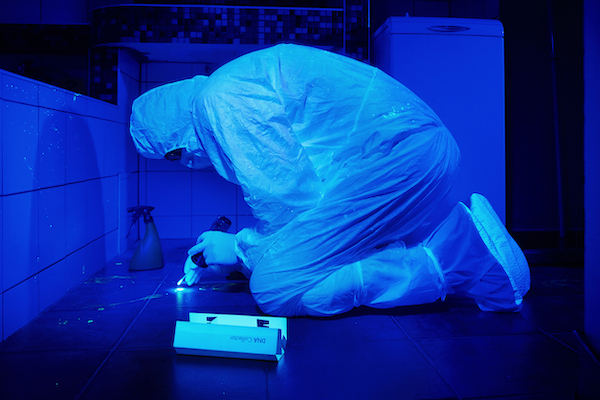Forensic investigators and researchers utilize a variety of light sources to examine the evidence found at a crime scene. Among a plethora of light sources, Ultraviolet (UV) light, in particular, has gained a positive reputation for efficient and effective examination of biologically contaminated evidence. As a matter of fact, the Federal Bureau of Investigation (FBI) recommends that every piece of evidence be analyzed using UV light.
There is a wide range of advantages that make UV light ideal for inspection of critical evidence. Perhaps the most important, though, is its property of keeping the evidence intact. Ultraviolet light does not damage or contaminate the evidence that conventional methods — like dusting — do.
On top of that, the use of UV light brings to the forefront critical pieces of evidence that could not have been detected with the unaided eye. It is especially praised for showing minute details of all clues, which aids in identifying critical pieces of information. Furthermore, a wide range of things can be detected using UV light, including all body fluids (e.g., blood, semen, saliva, or vaginal fluids), wounds, bruises, fingerprints, signatures, narcotics, paintings, and ink stains.
Understanding UV Light
Ultraviolet light is a form of energy produced by both natural and artificial sources. It is distinguished by its wavelength, which extends from approximately 180 nm to 400 nm.
- 180 nm to 280 nm is the short wavelength commonly used in chromatography, mineralogy, and sterilization.
- 380 nm to 320 nm is the medium wavelength and is transmitted through a quartz lens. It is used for therapeutic and cosmetic purposes.
- 320 nm to 400 nm is the long wavelength and is generated by portable lamps. This wavelength, in particular, is hugely beneficial to the forensic industry.
Standard Methods of UV Imaging
UV imaging is categorized into two types: reflective and fluorescent.
In reflective UV imaging, the concerned area of evidence is illuminated with UV light, and the reflected image is photographed. The lens of the camera that captures the image is fitted with a UV bandpass filter — a passive optical device that blocks all other sources of light returning to the film.
In the fluorescent UV imaging, though, the camera is outfitted with a different filter to block all UV rays coming back to the camera. As a result, only the visible light colors are captured in the film.
Reflected Ultraviolet Imaging System (RUVIS)
Reflected Ultraviolet Imaging System is a popular imaging system used by crime scene investigators and lab technicians to identify and analyze clues. The credit for designing this system goes to HORIBA France (a renowned optics firm formerly known as Jobin Yvon) that invented it in 1997.
RUVIS instruments are primarily used to identify and photograph latent fingerprints on non-porous surfaces. Latent fingerprints are the ones that are not visible to the naked eye but can be seen through optical instruments. To be identified, these fingerprints should not have undergone any standard treatments (such as dusting), and they must also not have been treated chemically. That being said, RUVIS instruments can help detect the fingerprints treated with superglue fumes, also known as cyanoacrylate vapor.
Though famous for identifying latent fingerprints, this technique is used to discover a variety of evidence, including bites, bruises, blood, gunshot residues, and shoe impressions.
RUVIS is considered a superior alternative to conventional evidence examination techniques, as it improves the quality of evidence for enhanced photography and collection — it is known for its sensitive handling of clues. In other words, RUVIS offers ultra-clear and detailed images for investigators to photograph or film.
Common Applications of RUVIS
RUVIS devices can reveal a wide range of evidence, bruises and patterned wounds being one of them — these are injuries that are not visible under normal white light illumination. By highlighting the details of an injury, they can help law enforcement find quick and accurate answers. For instance, the details of a wound can reveal the weapon used to injure the victim.
In addition, RUVIS instruments are ideal for crime scene scanning. Crime scene investigators and specialists leverage the RUVIS technology to observe a crime scene and ensure if all the necessary clues have been collected. Again, this helps save time by informing the investigators about the specific areas to focus on.
Moreover, the RUVIS method can also be integrated with other techniques to make the process of examining evidence more efficient. For example, a bloodstain, which is crucial evidence in many criminal cases, can be detected with the help of a chemical compound called luminol. The RUVIS instrument intensifies the chemiluminescence (the blue glow) of luminol, boosting the visibility of even the faintest of bloodstains.
The Cyanoacrylate treatment — also known as “superglue fuming” — is also anticipated to enhance the results produced by RUVIS instruments. Used in conjunction with each other, these techniques are expected to facilitate evidence examination on various surfaces.
Let Universe Kogaku’s lens application engineers supply you with the best lens solution.
At Universe Optics, we manufacture a wide range of Ultraviolet lenses ideal for different UV imaging systems and produce accurate and clear results. When fitted in instruments, they allow forensic investigators to collect evidence that is not easily noticeable or evidence that can easily escape the human eye. Our team of proficient engineers and manufacturers ensure the lenses meet all your needs and are customized to your applications. To discuss your unique requirements with us, get in touch at 1-516-624-2444 or contact us online today.